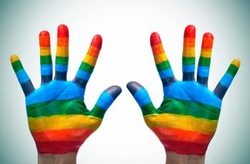 Over the past few weeks, I have taken numerous trips over to Conrad with Chris and Margeaux in order to gather information regarding the history of LGBT events and organizations at MSU. We have organized our findings into a time line which we feel accurately describes major events within the LGBT community here at MSU. In the beginning, I found the amount of information that was available on this subject slightly overwhelming. However, after spending some time sifting through folders filled with articles and newspapers, I began to get a sense of MSU’s history regarding the LGBT community. There were a few events in particular that stuck out to me as being the most influential. The first occurred in 1980, one of the years that Greek Week and Gay Pride week coincided on campus. Tensions between the two groups ran high throughout the week, coming to a head when, in order to mock the frat boys, all of the members of the gay community were told to wear “alligator shirts” and to dress as a stereotypical frat boy. The second noteworthy occasion occurred in 1982 when a member of the fraternity Delta Sigma Pi was removed from the fraternity after coming out as a gay. The president of the university stood behind the fraternity’s decision, claiming frats were not a part of the university and therefore not held to the same anti-discrimination policies as those of the university. After reading many stories similar to the ones outlined above, I am amazed at how far the university has come in response to the LGBT community in the past 30 or so years. The development and current existence of the LGBT resource center along with the evidence of changing attitudes throughout all of the Greek Community shows great promise for the reputation of our university in the future. I am so grateful for all of the changes that are contributing to MSU becoming a more accepting community for its students to be involved in.
Sarah
_ We’ve all heard the age-old aphorism “Sticks and stones can break my bones, but words can never hurt me.” It was the popular response to any form of insult, a verbal riposte that should have effectively ended the exchange. When I was in elementary school, we were taught to report physical bullying but to ignore verbal attacks; in effect, it was the victim’s fault if they let the hurtful words get to them. Cases of physical bullying at my school were rare, but recess was practically a verbal sporting match. Nobody was safe, and the words were brutal. Every day, for whatever reason, somebody would get called a “fag”, a “homo”, a “retard”, or a “gay-wad” (my computer has no idea how to style that last one, and neither do I). Though many of the kids who freely hurled these insults associated them with being a loser, few knew exactly what they meant. I went to elementary school in the mid-1990s, before major anti-hate campaigns were launched on television let alone the internet. There was nobody there to explain to us seven year-olds that by calling somebody a “fag” or a “retard”, we were a.) implying in the rudest way possible that the person on the receiving end was either homosexual or mentally handicapped and b.) that we were implying that being a homosexual or mentally handicapped was something to be scorned and ridiculed. The epithet “faggot” has a particularly nasty etymology; historically, faggots were groups of sticks tied together and used for large fires, and homosexuals were often burned as heretics or "abominations" in the past (homosexuality sadly continues to be punishable by death in certain countries). Not exactly something every elementary school student knows.
A more updated version of the aphorism should go “Sticks and stones can break my bones, but words will stay with me for life.” This works both ways. Many people my age continue to use these hurtful words simply because they have always used them and are unwilling to stop, despite knowing now exactly what they mean. Maybe its because they know what the words mean and what kind of connotation they bring when used that the insults have thus “stayed” with them. At this age, most people also know that epithets have lasting impacts on people; the internet is full of stories of people who committed suicide after enduring long bouts of verbal bullying. Maya Angelou once said that people may not remember what you said or what you did, but they do remember how you made them feel. In this way, hurtful words stay with those who have had to endure them for life.
Chris
Please watch the video above before reading.
This is an interesting way to look at the challenges faced by homosexual individuals in a heterosexual society. This video places you in a society where homosexuality is the norm, where "heteros" or "breeders" are shunned and mistreated just as homosexuals have been and are treated in our society. It flips traditional gender roles, posing the girls as playing football, the boys as acting. A "normal" relationship is one between two people of the same sex, the queer relationship between individuals of the opposite sex.
What I think this video really tells is that, beyond the science, the delineation, the criticisms in our society today, intolerance of homosexuality is mostly created by society. The video above presents it perfectly; there is no reason why we couldn't live this way, why this couldn't be where the world was and how people and relationships were perceived. Yet, its not, and most are going to find this really weird and disturbing because this is not what we have been trained to think normal. This is abomination from our perspective. But this kind of bullying and mistreatment really happens in society to those in the queer community of all ages and in different ways. If it is mostly society that breeds this hate, a society governed by us, then why can't we change things and stop this marginalization of other people?
Levi
One of the main arguments over human sexuality and equal rights for the LBGTQ community comes from the church. Not all religions believe in same-sex marriage, and many extremists openly express their beliefs of how it is “wrong.” This is hurtful for many, but everyone holds their own opinions. A group of Christians from Chicago realized how hurtful the Church can be towards LBGTQ and they went to a gay pride parade to apologize for homophobia in the Church.
The parade’s response was clearly forgiveness.
These two pictures restore some faith in humanity and give us hope for positive change.
Margeaux
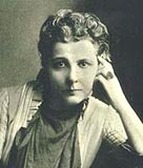 I have been studying sexual repression in the Victorian times to write a background on how sex was viewed during Darwin's career. In this research I have come across some truly inspiring historical figures that I may not have ever known about if I didn't have this project. Annie Besant has particularly inspired me, especially since this site has been highlighting a social issue of this time, which is how we view homosexuality. During Darwin's time there was not even rights for women, let alone people who were openly gay. Annie Besant took a stand to women's role in society as the caretaker of the family, in the 1870s she worked on the weekly National Reformer to advocate birth control, women's rights, and education. Thanks to Annie and others like her, I have the same rights to vote and work as a man. Her actions are what can inspire us today to sift through the facts of the media and science world and see that all people are equal, no matter what the eventual conclusion is to why humans are so diverse in their sexual behavior.
For more information visit: http://www.bbc.co.uk/history/historic_figures/besant_annie
Mary
Studying Darwin can get a little repetitive, especially because of his image as the father of evolution. Once you begin to get past the "Darwin wrote about evolution" part of research there is some very interesting information Darwin published that is lesser known to many. Darwin was particularly interested in birds and related many of their behaviors to sexual selection, and often to people's dismay linked bird behavior to human behavior. Darwin noted the natural plumage of male peacocks and the natural coy behavior of the female peacock and theorized that through this behavior, which is observable in the natural world, scientists would begin to understand how humans display the behaviors of sexual selection. Just for fun I looked up a few videos on other bird mating rituals to get a better understanding of how Darwin could study this subject so intensively, and I think with these videos it is easy to understand why.
Mary
There is a lot of hustle and bustle about legalizing gay marriage lately. Many celebrities take a stand on political issues and express their views to help popularize the issue and to aid in politicians’ campaigning. The artist, Macklemore, who recently performed in East Lansing, expresses his strong feelings about gay marriage through his music. In this popular music video, Macklemore raps about the typical stereotypes associated with homosexuality. He incorporates the hereditary aspect by thinking he is gay because “his uncle is,” and he emphasizes that since he can “keep his room straight” and “draw,” society tells him that he is gay. The touching lyrics mention that America fears the unknown and that “the right wing conservatives” think homosexuality can be cured with religion. It is a moving music video and a well-written rap that emphasizes that “Same Love” isn’t a choice with the lyric “I can’t change, even if I wanted to.”
Margeaux
On starting my research on Darwin and sexuality I was overwhelmed. Where do I start? Does Darwin even address sexual identity in his theory of evolution? These were all questions that vexed me and to be honest, hindered my initial research. I have now started to come to the realization that Darwin may not have explicitly written anything about gender identity or sexuality, but he started the conversation on sex. Darwin published during the Victorian era, a time when sex was considered necessary, but an evil only to be permitted in the institution of heterosexual marriage. People were not educated on the mechanisms of sex and saw sex and love as a mysterious, and (sometimes) divine part of humanity. Darwin changed this repressive culture of sex by uncovering the shroud of mystery behind sex, and pointing out its universal role in the natural world. Without Darwin, our understanding of sex and sexuality may have been a few years behind what it is today. It will be interesting to see how other scientists were inspired by Darwin’s naturalistic approach to sex.
Mary
_ Without deviation from the norm, progress is not possible.
-Frank Zappa
A word like progress has a general textbook definition, but what defines “the norm” varies wildly from person to person, much like the emotions a word like progress invokes. In a country still reeling from a real estate bubble collapse and recession, economic progress reads as a symbol of hope as people look ahead. Technological progress has defined how our generation communicates with each other. For many Americans, LGBTQ progress has nothing to do with civil rights progress, which evokes images of racial inequality and the rights finally granted to African Americans in the 1960s, nothing new. For them, the civil rights era has come and gone, an epoch to be fondly remembered, and the world in which they live today has become what they consider “the norm”. Of course, what was considered “the norm” fifty years ago was the exact reason for the start of the civil rights era in the first place. There came a time when a group of people realized that they disliked how the majority was defining “the norm”, and with hard work, dedication, and patience, they redefined it.
For the last few weeks, I have been combing both the Michigan State University and State News archives, looking for accounts that give perspective into how MSU’s community dealt with LGBTQ issues in the past to use as part of a timeline. The immediate thought I had was how amazing it was how far we’ve come. University studies from the early 1990s were met with a polarized reaction; news articles and eyewitness accounts from the 1980s and earlier portray a community aware of the presence of the LGBTQ community but intentionally deaf to its many voices; out of sight, out of mind dominated as the default attitude at MSU. One editorial response printed in the State News, published January 20, 1982, disparaged the State News for covering the dismissal of a fraternity brother based on his sexuality, and suggested they help put the gay rights movement “…back in the closet where it belongs.” My roommate, himself a member of MSU’s Greek community, assures me such attitudes are completely unwelcome in his fraternity today. Most people today would declare themselves progressive and would never harbor ugly or discriminatory feelings against another person. In spite of this, the future of LGBTQ progress hangs in the courts as the United States decides the fate of bills allowing or hindering gay marriage. Even the title of the Defense of Marriage Act explains the “norm” its proponents wish to preserve at the cost of progress, at the cost of basic civil rights.
The drawback of conveying progress with a timeline is that a timeline is constantly looking back when the nature of progress is always looking forward. It’s easy to look at the bad events of the past and contrast them to the present as evidence of progress and say, “Look how far we’ve come!” Doing this may add to our hindsight, but it diminishes the potential for change in the future. The timeline of LGBTQ progress has not ended, and for as far as we have come, there are still goals that need to be met and there is still a ways to go. The present’s status on the ongoing timeline is still undefined and yet unwritten; it is our responsibility to define what our present is and what our “norm” will be. Only then will we ever know where we are now.
Chris
|
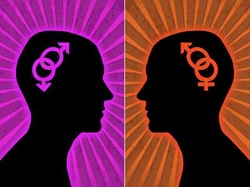

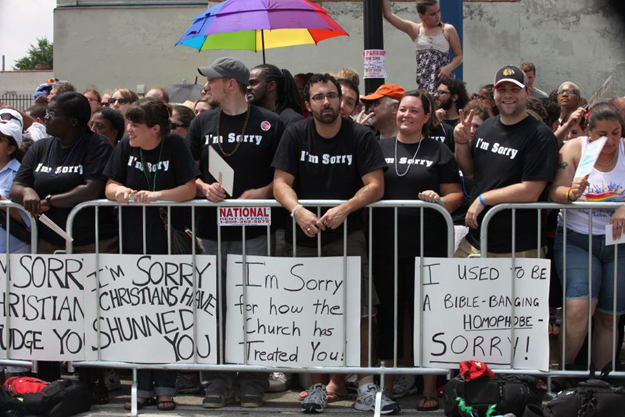
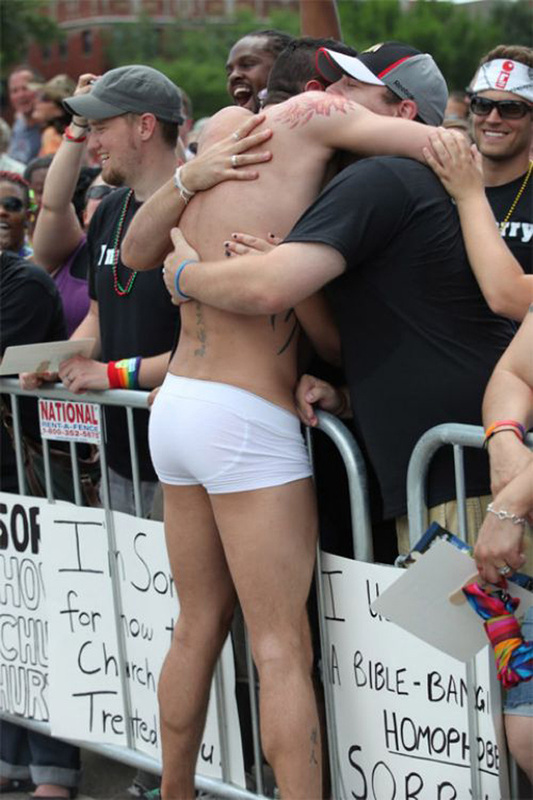

 RSS Feed
RSS Feed